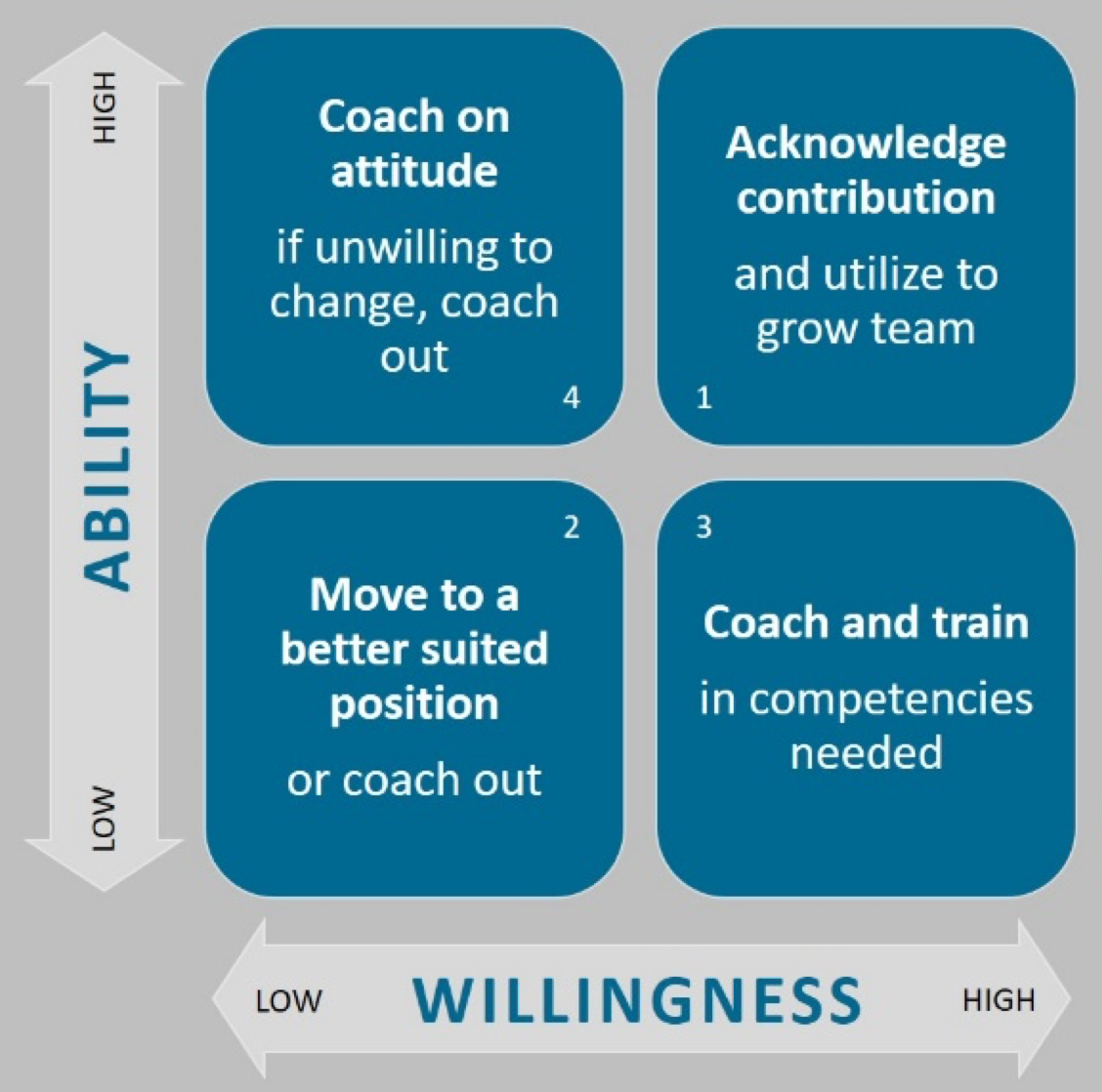First, determine if it is an issue of willingness or ability.
High willingness shows up as a great work ethic, always going above and beyond, taking on new responsibilities, and always willing to help out. Everyone loves working with a willing team member because they have a great attitude. It is generally hard to coach someone to be willing as most people either have it or they don’t. So make sure you are interviewing for it!
High ability shows up in the education, experience, and competencies. This person knows what they are doing, are great at their job, and can be seen as the “go to” person on the team for knowledge. With time and a plan, it is much easier to train people in a competency (ability) than it is to help them get a new attitude (willingness).
Let’s take a look at the four quadrants of coaching with the willingness and ability filters:

High Willingness and High Ability (1) – These are your superstars! They are the people you wish you could clone or duplicate. They are the high potentials that you know you can trust to run the show when you are not there. They are highly competent, great to be around, helpful, and supportive to the staff. Unfortunately, we usually don’t give them as much time as the low performers (the 80/20 rule applies here!). They often feel unappreciated and get stolen by the competition. Make sure you regularly show them appreciation, keep them engaged, and utilize their strengths to grow the rest of the team.
Low Willingness and Low Ability (2) – These are your high maintenance employees and you get very little return from spending your time on coaching them. Not only do they not have the competencies to do their job – nobody really enjoys working with them. They complain, gossip, and tend to drag the rest of the team down with drama and negativity. These employees can be toxic so don’t waste time moving them to a different position (if this is the reason they are failing) or letting them go (with proper procedures, for course). We find in nearly every case the rest of the team appreciates your taking action on these high maintenance individuals and the sooner the better. Once the issue is resolved, the team will be more productive and engaged without this person than they were with them.
High Willingness and Low Ability (3) – Spending time coaching these individuals is where you get the biggest return on your time. They have the willingness; they just need the competency training. Create a plan together to make sure they get the education, experience, training, and tools they need to be successful. If they are a quick learner and you have time to train them, this group that can move up to superstar status in no time.
High Ability and Low Willingness (4) – These individuals can often “handcuff” an organization. They are really good at their job (and they know it!) but they can be a real pain in the you-know-what to work with! You feel like you can’t let them go because much of the work wouldn’t get done or get done properly and then productivity and quality would suffer. But you also feel like you can’t keep them because they have such a negative effect on the team. You need to put a stake in the ground – let them know what behaviors are unacceptable, tell them exactly what needs to change, and give them a date by which they need to make those changes (usually 3 months). Provide them with any support they need even if it means hiring a coach for them. BUT, clearly outline the consequences if things don’t change (i.e., they will be demoted or let go).
So how do we utilize coaching to increase productivity and engagement?
Appreciate and leverage your superstar’s expertise so they feel valued and you don’t lose them. When a team member is a bad fit in either competency or attitude then move them or cut them lose. Focus your time and attention training the people with a great attitude to gain the skill set to be successful. Give your “I know it all and you can’t touch me” people an ultimatum to get with the program or else. And then watch the productivity and engagement of the team soar! A final note: I hope it goes without saying that any actions you take should be done in partnership with your HR professionals and company policies and practices.







